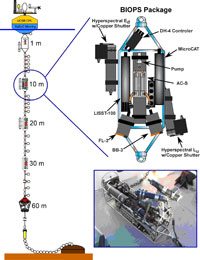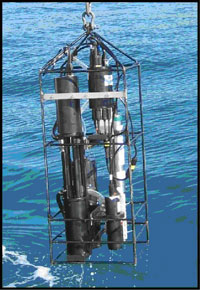Professor Tommy Dickey, a faculty member in the Department of Geography and the Graduate Program in Marine Sciences, is the principal investigator of the UCSB Ocean Physics Laboratory and has just received another major grant from The Office of Naval Research (ONR). The grant is part of a larger, ongoing ONR-sponsored study, and it will allow the deployment of two new systems designed to measure attributes of the physics and optics of the ocean’s surface boundary layer. To quote the Abstract of the proposal:
The Office of Naval Research (ONR) has recently funded a comprehensive study devoted to the improvement of the fundamental understanding of the physics and optics of the ocean’s surface boundary layer (SBL). The study, called Radiance in a Dynamic Ocean (RaDyO), is the first to attack this challenging and highly complex problem. Our focus is on physical and optical measurements in the dynamic near surface layer of the ocean. Two new measurement systems, which will be dedicated to the ONR RaDyO experiment, are requested in this proposal. The first will be used to obtain high temporal resolution measurements using a moored system and the second will be a profiling system for high vertical spatial resolution observations. Both systems will provide unique stand-alone physical and optical data streams, which will also be critical for the interpretation of data sets obtained by other RaDyO observationalists and for the development and testing of theories and models of RaDyO investigators. The systems will be used to resolve high temporal and vertical variability of ocean optical, including radiance, and physical properties of the surface and upper ocean boundary layers. The specific purpose of our proposed research is to obtain, analyze, and model radiance, inherent optical property (IOP), and apparent optical property (AOP) data sets, and to relate these to physical processes in the upper oceanic layer and SBL as well as forcing by atmospheric conditions and solar insolation. Our RaDyO research builds upon 25 years of experience in conducting ONR optical and physical field experiments.
Dr. Grace Chang, Associate Researcher at OPL, is the Co-PI of the grant proposal, and Tommy and Grace are the lead PIs for the entire RaDyO project which includes several institutions and will be conducted in the Santa Barbara Channel and off Point Conception using multiple research platforms, including R/P FLIP, in the next few years. More details can be found at http://www.opl.ucsb.edu/; also see the RaDyO website , which describes several past and current projects and includes an extensive bibliography of papers and reports.
Figure 1. [click images to enlarge] (Left:) Schematic diagram of the RaDyO Mooring System, featuring a surface buoy with: meteorological sensors; 1 m package with acoustic current meter and radiometer (Lu); 10 m bio-optical system (BIOPS) with radiometers (Ed and Lu), LISST-100, hyperspectral a-c meter (ac-s), spectral backscattering sensor (bb-3), spectral fluorometer (fl-3), and C-T sensor (microcat); 20 m BIOPS with radiometers (Ed and Lu), spectral backscattering sensor, fluorometer, turbidity sensor, and C-T sensor; 30 m BIOPS with spectral backscattering sensor, fluorometer, turbidity sensor, and C-T sensor; 60 m ADCP with fluorometer, turbidity sensor, and C-T sensor. Temperature sensors span the water column. (Top Right:) Schematic diagram of the 10 m BIOPS. (Bottom Right:) Photograph of a similar BIOPS package (length is 1.75 m).
Figure 2. [click images to enlarge] (Left:) Schematic diagram of the RaDyO Profiling System featuring an ac-s, filtered ac-9 for absorption of dissolved matter, PAR sensor (for photosynthetically available radiation), FL-NTU, bb-9, CTD, DH-4, and battery pack. (Right:) Photograph of a similar optical-physical profiling package.

(1).jpg)




